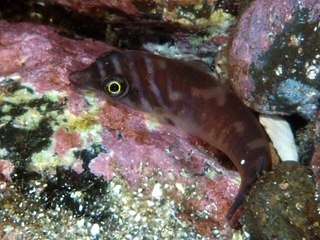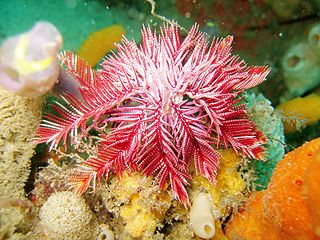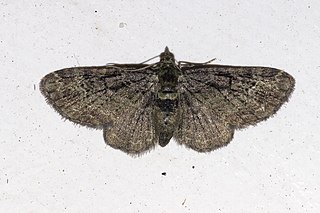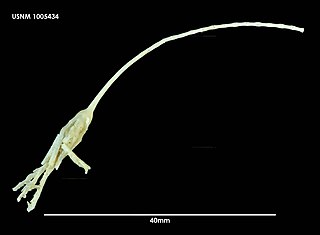
An echinoderm is any member of the phylum Echinodermata. The adults are recognisable by their radial symmetry, and include starfish, brittle stars, sea urchins, sand dollars, and sea cucumbers, as well as the sea lilies or "stone lilies". Adult echinoderms are found on the sea bed at every ocean depth, from the intertidal zone to the abyssal zone. The phylum contains about 7,000 living species, making it the second-largest grouping of deuterostomes, after the chordates. Echinoderms are the largest entirely marine phylum. The first definitive echinoderms appeared near the start of the Cambrian.

Crinoids are marine animals that make up the class Crinoidea. Crinoids that are attached to the sea bottom by a stalk in their adult form are commonly called sea lilies, while the unstalked forms, called feather stars or comatulids, are members of the largest crinoid order, Comatulida. Crinoids are echinoderms in the phylum Echinodermata, which also includes the starfish, brittle stars, sea urchins and sea cucumbers. They live in both shallow water and in depths as great as 9,000 meters (30,000 ft).

Sergey Mikhailovich Mironov is a Russian politician. He was chairman of the Federation Council, the upper house of the Russian parliament, from 2001 to 2011. He leads the faction A Just Russia in the Parliament of Russia.

Clingfishes are fishes of the family Gobiesocidae, the only family in the order Gobiesociformes. These fairly small to very small fishes are widespread in tropical and temperate regions, mostly near the coast, but a few species in deeper seas or fresh water. Most species shelter in shallow reefs or seagrass beds, clinging to rocks, algae and seagrass leaves with their sucking disc, a structure on their chest.

Articulata are a subclass or superorder within the class Crinoidea, including the only living crinoid species. They are commonly known as sea lilies or feather stars. The Articulata are differentiated from the extinct subclasses by their lack of an anal plate in the adult stage and the presence of an entoneural system. Articulata first appeared in the fossil record during the Triassic period although other, now extinct crinoid groups, originated in the Ordovician.

Comasteridae is a family of crinoids.

Pasiphila is a genus of moths in the family Geometridae. As of 2005 about 36 species were known, and of these, some 27 are native to New Zealand.

Bathycrinidae is a family of echinoderms in the class Crinoidea. It contains the following genera and species:

Comatulida is an order of crinoids. Members of this order are known as feather stars and mostly do not have a stalk as adults. The oral surface with the mouth is facing upwards and is surrounded by five, often divided rays with feathery pinnules. Comatulids live on the seabed and on reefs in tropical and temperate waters.

Bourgueticrinida is an order of crinoids that typically live deep in the ocean. Members of this order are attached to the seabed by a slender stalk and are known as sea lilies. While other groups of crinoids flourished during the Permian, bourgueticrinids along with other extant orders did not appear until the Triassic, following a mass extinction event in which nearly all crinoids died out.
Bathycrinus aldrichianus is a species of sea lily, a crinoid in the family Bathycrinidae. It is native to deep water in the North Atlantic Ocean. It was first described by the Scottish marine zoologist Charles Wyville Thomson and named in honour of Pelham Aldrich, a British naval officer and explorer. It is believed to be the crinoid living at the greatest depth.

Bathycrinus australis is a species of sea lily, a crinoid in the family Bathycrinidae. It is native to deep water in the Antarctic Ocean. It was initially identified as Bathycrinus aldrichianus by Philip Herbert Carpenter following the 1872-1876 HMS Challenger expedition. It was later distinguished as a new species by the American zoologist Austin Hobart Clark.
Bathycrinus australocrucis is a species of sea lily, a crinoid in the family Bathycrinidae. It is native to the New Zealand region. It was described by D. G. McKnight.
Bathycrinus carpenterii is a species of sea lily, a crinoid in the family Bathycrinidae. It is native to the North Atlantic. It was described by Danielssen & Koren.

Bathycrinus gracilis is a species of sea lily, a crinoid in the family Bathycrinidae. It is native to the North Atlantic. It was described by Charles Wyville Thomson.
Discolocrinus thieli is a species of sea lily, a crinoid in the family Bathycrinidae. It is native to the eastern Pacific Ocean. It was described by A. N. Mironov. It is named in honor of deep sea ecologist Hjalmar Thiel.

Comatulidae is a family of comatulid crinoids. Since 2015, it replaces the family Comasteridae.

Bathycrinus is a genus of crinoids.

Florometra serratissima is a species of crinoid or feather star in the family Antedonidae. It is found off the Pacific coast of North America, usually in deep water.













